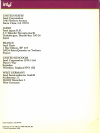
80386
Register Specified
by
reg Field
During 32-Bit Data Operations
Function
of
w Field
reg
(whenw
= 0)
(whenw
= 1)
000
AL
EAX
001
CL
ECX
010 DL EDX
011
BL
EBX
100
AH
ESP
101
CH
EBP
110
DH
ESI
111
BH
EDI
8.2.3.3 ENCODING OF THE SEGMENT
REGISTER (sreg) FIELD
The sreg field
in
certain instructions is a 2-bit field
allowing one of the four 80286 segment registers to
be
specified. The sreg field
in
other instructions is a
3-bit field, allowing the 80386
FS
and
GS
segment
registers to be specified.
2-Bit sreg2 Field
2-Bit
Segment
sreg2
Field
Register
Selected
00
ES
01
CS
10
SS
11
DS
3-Bit sreg3 Field
3-Bit
Segment
sreg3 Field
Register
Selected
000
ES
001
CS
010
SS
011
DS
100
FS
101
GS
110
do not use
111
do not use
127
8.2.3.4
ENCODING
OF
ADDRESS MODE
Except for special instructions, such as
PUSH or
POP,
where the addressing mode is pre-determined,
the addressing mode for the current instruction is
specified
by
addressing bytes following the primary
opcode. The primary addressing byte
is
the "mod
rim" byte, and a second byte of addressing informa-
tion, the "s-i-b" (scale-index-base) byte, can be
specified.
The s-i-b byte (scale-index-base byte) is specified
when using 32-bit addressing mode and the
"mod
rim" byte has rim = 100 and mod = 00,01 or 10.
When the sib byte
is
present, the 32-bit addressing
mode is a function of the mod,
ss,
index, and base
fields.
The primary addressing byte, the
"mod rim" byte,
also contains three bits (shown
as
TTT
in
Figure 8-1)
sometimes used as
an
extension of the primary op-
code. The three bits, however, may also
be
used as
a register field (reg).
When calculating an effective address, either 16-bit
addressing or 32-bit addressing is used. 16-bit
ad·
dressing uses 16-bit address components to calcu-
late the effective address while 32-bit addressing
uses 32-bit address components to calculate the
ef-
fective address. When 16-bit addressing is used, the
"mod rim" byte is interpreted
as
a 16-bit addressing
mode specifier. When 32-bit addressing is used, the
"mod rim" byte is interpreted
as
a 32·bit addressing
mode specifier.
Tables on the following three pages define all
en-
codings of all 16-bit addressing modes and 32-bit
addressing modes.


















